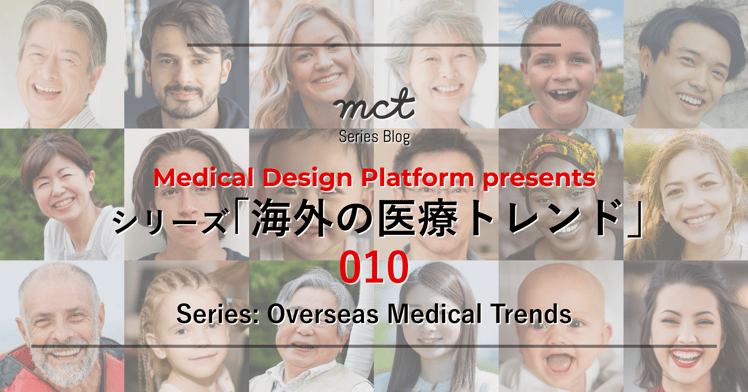2024.10.09
Series Blog|シリーズ 「海外の医療トレンド」 010 Overseas Medical Trends

シリーズ「海外の医療トレンド」は、mctのメディカルデザインプラットフォームがお届けする、
海外の医療情報をテーマとしたシリーズブログです。
“Overseas Medical Trends" is a series of blogs on overseas medical information,
brought to you by mct's "Medical Design Platform".
brought to you by mct's "Medical Design Platform".
「メディカルデザインプラットフォーム」は、顧客視点でビジネスの問題解決をお手伝いしている
株式会社mctの「患者さん中心の医療」に関わる情報やサービスを提供するユニットです。
株式会社mctの「患者さん中心の医療」に関わる情報やサービスを提供するユニットです。
"Medical Design Platform" helps solve business problems from the customer's perspective.
It is a unit that provides information and services related to "patient-centered medicine" of mct Inc.
It is a unit that provides information and services related to "patient-centered medicine" of mct Inc.
Vol.6
ベトナムの医療の現状と課題
The Current State of Medical Care in Vietnam and Challenges
The Current State of Medical Care in Vietnam and Challenges
こんにちは、ミーハです。私はベトナム出身で日本に住んで約14年になります。今回は母国ベトナムの医療について、日本の医療制度と比較しながら紹介したいと思います。ベトナムの医療システムを理解することで、日本の製薬企業やヘルスケア事業者が、急速に発展しているベトナムの医療市場について価値ある情報を得られることを願っています。これらの情報は、日本の医療機関がベトナムとの協力関係を築き、文化の違いを理解しながら、両国に利益をもたらす革新的な取り組みを生み出すのに役立つ有意義なパートナーシップを築くのに役立てば幸いです。
Hello, I'm My Ha. Originally from Vietnam, I've been living in Japan for about 14 years. In this post, I’ll be sharing insights about healthcare in my home country, Vietnam, in comparison to some aspects of Japan. I hope that understanding Vietnam's healthcare system provides Japanese healthcare providers with valuable insights into a dynamic and evolving market. These insights can help Japanese healthcare services explore opportunities for collaboration, adapt to cultural nuances, and foster meaningful partnerships that drive innovation benefiting both countries.
◆ベトナムの医療制度の概要
Brief Overview of Vietnam’s Healthcare System

ベトナムは多様で複雑な医療システムを持ち、近年大きな変化を遂げています。経済成長と発展が急速に進む中、ベトナムの医療分野も、人口増加に伴う人々のニーズに応えるべく進化を続けています。そしてベトナムの医療システムをより詳しく見ることで、日本のシステムと比較するのは興味深いところです。
Vietnam has a diverse and complex healthcare system that has undergone significant changes in recent decades. As the country has experienced rapid economic growth and development, the healthcare sector has evolved to meet the needs of its growing population. It would be interesting to compare the healthcare systems of Japan and Vietnam by taking a closer look at Vietnam’s healthcare system.
Vietnam’s healthcare system is a blend of public and private services, with the government striving toward universal healthcare coverage.
◆公的医療 Public Healthcare
ベトナムの公的医療システムは国の医療インフラの中核を成しています。ベトナム民間病院協会によると、2022年末時点で公立病院が病院総数の約80%、病床数の98%を占めています。これは主に保健省によって管理され、病院、診療所、コミュニティヘルスセンターのネットワークで構成されています。これらの施設は政府の資金で運営され、ベトナム国民に補助金付きまたは低コストの医療を提供しています。
ベトナムの公的医療システムは国の医療インフラの中核を成しています。ベトナム民間病院協会によると、2022年末時点で公立病院が病院総数の約80%、病床数の98%を占めています。これは主に保健省によって管理され、病院、診療所、コミュニティヘルスセンターのネットワークで構成されています。これらの施設は政府の資金で運営され、ベトナム国民に補助金付きまたは低コストの医療を提供しています。
対照的に、日本の病院の大半は民間で、15%が国、都道府県、市町村が所有する公立病院です。これらの病院は全国に分布し、アクセスの良さを確保しています。厚生労働省は病院の治療を厳密に監視し、費用を規制するために診療報酬を設定しています。
Vietnam’s public healthcare system is the backbone of the country’s healthcare infrastructure. Public hospitals dominate the system, accounting for nearly 80% of the total number of hospitals and 98% of patient beds in Vietnam by the end of 2022, according to the Việt Nam Private Hospital Association. It is primarily managed by the Ministry of Health and consists of a network of hospitals, clinics, and community health centers. These facilities are government-funded and provide subsidized or low-cost care to Vietnamese citizens.
In contrast, the majority of hospitals in Japan are private, while 15% are public hospitals owned by the national government, prefectures, and municipalities. These hospitals are distributed across the country, ensuring accessibility. The Ministry of Health, Labor, and Welfare closely monitors hospital treatments and sets a fee schedule to regulate costs.
さて、ベトナムの公立病院システムは中央、省、地区の3つのレベルに分かれています。
中央レベルの病院は最大規模で最も設備が整っており、しばしば複雑な医療ケースの紹介センターとして機能します。省レベルの病院は通常、地区レベルの病院よりも大きく、より幅広いサービスを提供しています。地区レベルの病院は小規模で、プライマリケアと基本的な医療サービスに焦点を当てています。
病院に加えて、ベトナムには多くの農村部や遠隔地で医療の主要な入り口となるコミュニティヘルスセンター(CHC)のネットワークがあります。これらのセンターは地域社会に基本的な医療サービス、予防ケア、健康教育を提供しています。このシステムはパンデミックなどの公衆衛生問題の管理においても重要な役割を果たしています。
ベトナムの公立病院は多くの場合、資金不足に直面しており、これが設備や施設の老朽化、過密化の問題につながっています。一方、日本の公立病院は政府からの手厚い財政的バックアップにより、設備の整った高品質の施設を維持することができています。
The public hospital system in Vietnam is divided into three levels: central, provincial, and district.
Central-level hospitals are the largest and most well-equipped, often serving as referral centers for more complex medical cases. Provincial hospitals are typically larger than district hospitals and offer a wider range of services. District-level hospitals are smaller and focus on primary care and basic medical services.
In addition to hospitals, Vietnam has a network of community health centers (CHCs) that serve as the primary entry point for healthcare in many rural and remote areas. These centers provide basic medical services, preventive care, and health education to local communities. This system also plays a key role in managing public health issues, such as pandemics, due to its extensive reach.
Public hospitals in Vietnam often face underfunding, leading to outdated equipment, facilities, and overcrowding issues. Meanwhile, Japan’s public hospitals receive substantial government funding, allowing them to stay well-equipped and maintain high-quality facilities.
◆民間医療 Private Healthcare
公的医療システムが医療サービスの主要な提供者であり続けている一方で、ベトナムの民間医療部門は近年大きく成長しています。民間の病院、診療所、専門センターは様々なサービスを提供しており、多くの場合、成長する中産階級や外国人居住者のニーズに応えています。ベトナムの民間医療施設は、規模、専門性、ケアの質において大きく異なる場合があります。全体として、ベトナムの民間病院は一般的に近代的で設備が整っており、公立病院と比べてより高水準のケアを提供していますが、一部の施設ではリソースや能力が限られている場合があります。
公的医療システムが医療サービスの主要な提供者であり続けている一方で、ベトナムの民間医療部門は近年大きく成長しています。民間の病院、診療所、専門センターは様々なサービスを提供しており、多くの場合、成長する中産階級や外国人居住者のニーズに応えています。ベトナムの民間医療施設は、規模、専門性、ケアの質において大きく異なる場合があります。全体として、ベトナムの民間病院は一般的に近代的で設備が整っており、公立病院と比べてより高水準のケアを提供していますが、一部の施設ではリソースや能力が限られている場合があります。
民間の病院やクリニックは、より高品質のサービスと短い待ち時間を提供しますが、費用は高くなります。多くのベトナム人、特に高所得者層は、より良いサービスと先進的な医療治療を受けるために民間医療を選択します。新しい規制により、国民健康保険に加入している患者は、保険システムと契約している民間病院でもカバーされるようになりましたが、ほとんどの民間病院は健康保険でカバーされていないか、部分的にしかカバーされていません。ベトナムの継続的な経済発展、中産階級の成長、高品質の医療サービスへの需要の増加、そして民間医療の成長を支援する政府の努力が、医療システムの主要な推進力となっています。
日本の病院は基本的に非営利組織として運営されており、通常は医師が所有・管理しています。日本政府は医療費を厳しく監督・規制し、一般市民にとって手頃な費用に維持されています。民間病院も日本の国民健康保険制度に含まれており、患者は公立病院と同じ保険給付で民間病院での治療を受けることができます。患者は自分の好みやニーズに基づいて公立病院と民間病院を自由に選択することができます。
While the public healthcare system remains the dominant provider of medical services, Vietnam’s private healthcare sector has grown significantly in recent years. Private hospitals, clinics, and specialized centers offer a range of services, often catering to the needs of the country’s growing middle class and expatriate population. Private healthcare facilities in Vietnam can vary greatly in terms of size, specialization, and quality of care. Overall, private hospitals in Vietnam are generally modern, well-equipped, and offer a higher standard of care compared to public hospitals, though some may have more limited resources and capabilities.
Private hospitals and clinics offer higher quality services and shorter wait times but are more expensive. Many Vietnamese people, especially those with higher incomes, choose private healthcare for better service and advanced medical treatments. Although new regulations allow patients with universal healthcare insurance to be covered in private hospitals that have contracts with the insurance system, most private hospitals are either only partially covered or not covered at all by healthcare insurance. Vietnam’s continued economic development, growth of the middle class, increasing demand for high-quality healthcare services, and government efforts to support the growth of private healthcare are key drivers in the healthcare system.
Hospitals in Japan fundamentally operate as non-profit organizations and are typically owned and managed by physicians. The Japanese government oversees and strictly regulates medical fees to keep treatments affordable for the public. Private hospitals are included in Japan’s universal health insurance system, meaning patients can receive treatment at these hospitals with the same insurance benefits as at public hospitals. Patients have the freedom to choose between public and private hospitals based on their preferences and needs.
◆医療の財政と保険
Healthcare Financing and Insurance
Healthcare Financing and Insurance

ベトナムは政府が提供する社会健康保険を通じて国民皆保険制度の実現を目指しています。ベトナム社会保障(VSS)として知られる国民健康保険制度は、人口の大多数をカバーする強制的な制度です。雇用主と被雇用者はこのシステムに貢献することが求められ、正式に雇用されていない個人も自主的に加入することができます。2024年現在、人口の約93.4%が健康保険に加入しており、貧困層、少数民族、6歳未満の子供、80歳以上の高齢者の健康保険費用は政府が全額負担しています。この点においてはベトナムと日本の事情はよく似ています。日本の国民皆保険制度は有名で、法定健康保険制度(SHIS)が人口の98.3%をカバーし、残りの1.7%は貧困者のための公的社会扶助プログラムでカバーされています。
ベトナム社会保障のプログラムは、入院と外来ケア、診断テスト、特定の種類の治療など、幅広い医療サービスをカバーしています。保険のカバー範囲と自己負担要件は、個人の加入状況と必要とする特定のサービスによって異なる場合があります。また、このプログラムはベトナムの医療へのアクセスの改善に貢献していますが、特定の治療や薬のカバー範囲の制限、公共施設での長い待ち時間、都市部と農村部のケアの質の格差など、依然として課題に直面しています。
Vietnam is striving toward a universal healthcare system through government-provided social health insurance. The national health insurance program, known as Vietnam Social Security (VSS), is a compulsory scheme that covers the majority of the population. Employers and employees are required to contribute to the system, and individuals who are not formally employed can also enroll voluntarily. As of 2024, about 93.4% of the population has health insurance coverage. The government fully covers health insurance costs for the poor, ethnic minorities, children under six, and elderly people over 80. Vietnam and Japan are similar in this aspect. Japan is well known for its universal health coverage, with its statutory health insurance system (SHIS) covering 98.3% of the population, while the remaining 1.7% is covered through the public social assistance program for impoverished individuals.
The VSS system provides coverage for a wide range of medical services, including inpatient and outpatient care, diagnostic tests, and certain types of treatments. The level of coverage and co-payment requirements can vary depending on the individual’s enrollment status and the specific services they require. While the VSS system has helped improve access to healthcare in Vietnam, it still faces challenges, such as limited coverage for certain treatments and medications, long waiting times at public facilities, and disparities in the quality of care between urban and rural areas.
The VSS system provides coverage for a wide range of medical services, including inpatient and outpatient care, diagnostic tests, and certain types of treatments. The level of coverage and co-payment requirements can vary depending on the individual’s enrollment status and the specific services they require. While the VSS system has helped improve access to healthcare in Vietnam, it still faces challenges, such as limited coverage for certain treatments and medications, long waiting times at public facilities, and disparities in the quality of care between urban and rural areas.
◆主な課題
Key Challenges
Key Challenges

ベトナムの医療システムは、有資格の医療スタッフ不足、老朽化した施設、そして高齢化と非感染性疾患の蔓延による医療サービスへの高い需要など、いくつかの課題に直面しています。ほとんどの病院は老朽化しており、また慢性的な過密状態に悩まされています。ハノイとホーチミン市の病院は、国内患者の最大60%を受け入れており、収容能力200%で運営されている状況にあります。このように、ベトナムの医療システムは多くの課題を抱えており、早急な改善が求められています。
出生率の低下と並んで、ベトナムの高齢化は医療サービスと製品への需要増加をもたらしています。WHO(世界保健機関)によると、ベトナムの総死亡数の約74%は非感染性疾患(NCDs)によるものです。ベトナムは世界で最も急速に高齢化が進む国のひとつであり、2036年までに高齢化社会に突入すると予想されています。2023年の統計によれば、人口の約22%が慢性疾患に苦しんでおり、ベトナムの高齢者は平均して3~4の疾病を抱えているとのことです。このような状況から、ベトナムの医療システムは今後さらなる課題に直面することが予想されます。高齢化と疾病構造の変化に対応するため、医療サービスの拡充と質の向上が急務となっているのが現状です。
Vietnam’s healthcare system faces several challenges, including a shortage of qualified medical staff, outdated facilities, and high demand for healthcare services due to an aging population and the prevalence of non-communicable diseases. Most hospitals are outdated and suffer from chronic overcrowding. Hospitals in Hanoi and Ho Chi Minh City receive up to 60% of the country’s patients and operate at 200% of their capacity.
Along with the declining birth rate, Vietnam’s aging population is resulting in higher demand for healthcare services and products. According to the WHO, non-communicable diseases (NCDs) account for approximately 74% of total deaths in Vietnam. Vietnam is one of the countries with the fastest-aging populations in the world and is expected to enter the aging population period by 2036. About 22% of the population suffers from chronic diseases, and on average, each elderly Vietnamese person suffers from 3 to 4 diseases, according to 2023 statistics.
◆医療機器の必要性
Need for Medical Equipment
Need for Medical Equipment

ベトナムの公立病院における既存の医療機器の多くは老朽化しており、交換が必要な状況にあります。多くの病院では手術や集中治療室に必要な機器が不足しているのが現状です。ベトナムの医療機器の90%以上が輸入品であり、医療サービスを向上させるための最新機器の需要が大きくなっています。病院側も、施設のアップグレードと拡張、運営効率の改善、そしてより良いサービス提供を目指し、先進的な医療機器への投資を進めています。このような取り組みは、ベトナムの医療システム全体の質を向上させる重要な一歩となっているでしょう。しかし、資金面での課題や技術導入の遅れなど、まだ多くの障壁が存在しているのも事実です。今後、政府や民間セクターの協力により、これらの課題を克服し、より充実した医療環境の構築が期待されています。
エコノミスト・インテリジェンス・ユニット(EIU)の報告によると、2022年のベトナムの医療支出は約185億ドルに達し、これは国内総生産(GDP)の4.6%を占めています。ベトナムの公立病院は、施設、設備、サービスのアップグレードに関して、主に国家予算に依存しているのが現状です。確かに、保健分野への総予算は増加傾向にありますが、増大する需要を満たすには依然として不十分な水準にとどまっています。このギャップは、ベトナムの医療システムが直面する重要な課題のひとつとなっています。今後、政府の更なる投資や民間セクターとの協力が、この問題解決の鍵を握るかもしれません。また、効率的な予算配分や医療資源の有効活用も、限られた資金で最大の効果を得るために重要な戦略となるでしょう。
多くの病院で資格のある医療スタッフが不足しているのが一般的な状況です。特に公立病院やクリニックでは、医師や看護師がストレスの多い環境下で比較的低い賃金で働いています。充実した医学教育システムがあるにもかかわらず、ベトナムは医療従事者の維持と育成に大きな課題を抱えています。より良い給与と労働条件を求めて、多くの高度な訓練を受けた医療専門家が公立施設を離れ、民間病院へ移動したり、海外での機会を求めたりする「頭脳流出」現象が起きているのです。この状況は、ベトナムの医療システム全体に深刻な影響を及ぼしています。医療の質を維持し向上させるためには、医療従事者の待遇改善や、キャリア発展の機会の提供など、包括的な対策が必要となるでしょう。政府も、この問題の解決に向けて様々な施策を検討していますが、即効性のある解決策の実施は容易ではありません。
Much of the existing medical equipment in public hospitals in Vietnam is outdated and needs replacement. Many hospitals lack sufficient equipment for surgeries and intensive care units. Over 90% of medical equipment in Vietnam is imported, and there is a significant need for modern devices to enhance healthcare services. To upgrade and expand their facilities, improve operational efficiency, and provide better services, hospitals are investing in advanced medical devices.
According to the Economist Intelligence Unit (EIU), Vietnam’s healthcare expenditure was approximately USD 18.5 billion in 2022, representing 4.6% of the country’s GDP. Vietnamese public hospitals rely largely on the state budget to upgrade their facilities, equipment, and services. Although the total budget for the health sector has increased, it remains insufficient to meet growing demands.
A shortage of qualified medical staff is common in many hospitals. Doctors and nurses often work under stressful conditions with relatively low wages, especially in public hospitals and clinics. Despite a robust medical education system, Vietnam faces significant challenges in maintaining and developing its healthcare workforce. The country has experienced a "brain drain," as many highly trained healthcare professionals leave public facilities for private hospitals or seek opportunities abroad due to better salaries and working conditions.
◆都市部と農村部の格差
Urban-Rural Disparities
Urban-Rural Disparities

ベトナムの医療システムが直面する重要な課題のひとつに、都市部と農村部、そして異なる社会経済グループ間での医療サービスへのアクセスに大きな格差があることが挙げられます。ベトナムの医療従事者の多くは都市部に集中しており、多くの農村部や遠隔地では医療人材が不足しているのが現状です。都市部に住む人々は一般的に、医療施設、先進的な医療技術、様々な専門サービスへのアクセスが良好です。一方、農村部や遠隔地の住民は、長い移動時間、乏しい医療資源、限られた専門的ケアの選択肢に直面することが多いのです。
この状況は、地域レベルの医療施設への信頼不足を招き、患者が大都市へ移動せざるを得なくなり、中央病院の過密問題をさらに悪化させています。保健省によると、質の高い医療サービスがベトナム国内で広く利用できないため、約4万人のベトナム人が年間約20億ドルを海外での医療サービスに費やしているとのことです。このような現状は、ベトナムの医療システムが抱える深刻な課題を浮き彫りにしており、早急な対策が求められています。都市部と農村部の格差解消、医療資源の適切な分配、そして国内医療の質の向上が、今後の重要な課題となっているでしょう。
Another key challenge facing the Vietnamese healthcare system is the significant disparity in access to medical services between urban and rural areas, as well as among different socioeconomic groups. Most healthcare professionals in Vietnam are concentrated in urban areas, leaving many rural and remote communities with a shortage of medical personnel. People living in urban areas generally have better access to healthcare facilities, advanced medical technologies, and a wider range of specialist services. In contrast, rural and remote communities often face longer travel times, fewer healthcare resources, and more limited options for specialized care.
This situation has led to a lack of trust in local-level healthcare facilities, forcing patients to travel to large cities, which exacerbates overcapacity issues in central hospitals. High-quality healthcare services are not yet widely available in Vietnam, leading around 40,000 Vietnamese people to spend approximately USD 2 billion annually on medical services abroad, according to the Ministry of Health.
 ーーーーーーーーーーーーーーーーーーーーーーーーーーーーーーーーーーーーーーーーーーーーーーーー
ーーーーーーーーーーーーーーーーーーーーーーーーーーーーーーーーーーーーーーーーーーーーーーーー
◆薬と医療に関する文化的・社会的習慣
Cultural and Social Habits Related to Medicines and Healthcare
Cultural and Social Habits Related to Medicines and Healthcare
ベトナムでは人々が病気になったときの考え方や治療法の選び方がひとつではなく様々です。それはベトナムの文化や社会の特徴が大きく影響しています。例えば、伝統的な考え方や現代医学、宗教的な信念など、さまざまな要素が絡み合って、病気への対処方法が形作られています。
People in Vietnam have a diverse and complex approach to illness and treatment, rooted in cultural and social elements.
◆セルフメディケーション Self-Medication

セルフメディケーションとは、処方箋なしで、または非専門家の推奨に従って、医薬品を使用して病気や症状を治療する行為を指します。責任あるセルフメディケーションは、処方箋なしで使用が公式に認められた医薬品を使用することを含みます。一方、無責任なセルフメディケーションは、処方箋なしで使用すべきでない薬を使用することを意味します。
ベトナムでは、責任あるセルフメディケーションと無責任なセルフメディケーションの両方が広く行われています。都市部でも農村部でも、多くの人々が様々な症状に対して薬を入手するために薬局を訪れることを選択しているのが現状です。通常は処方箋が必要な薬でさえ、薬局で簡単に購入できてしまいます。ベトナムには25,000種類以上の薬が流通しており(機能性食品を除く)、そのうち40%以上が、処方箋が必要な薬となっています。しかし、実際には、ほぼすべての処方薬が薬局や薬店で処方箋なしに簡単に購入できてしまうのです。患者は多くの場合、友人や家族からのアドバイス、または過去の経験に基づいてセルフメディケーションを行っています。このような状況は、ベトナムの医療システムにおける重要な課題のひとつとなっており、適切な規制と教育の必要性を浮き彫りにしています。セルフメディケーションの適切な実践と、医療専門家の適切な関与のバランスを取ることが、今後の重要な課題となるでしょう。
また、この慣行は抗生物質耐性のリスクを高めており、ベトナムは世界で最も抗生物質耐性率が高い国のひとつとなっています。統計によると、ベトナムで使用される薬の50%以上が抗生物質であり、これは非常に高い割合で、深刻な抗生物質耐性のリスクに寄与しています。抗生物質は医師の処方箋で購入すべき薬剤ですが、2009年以降、一般に販売される抗生物質の数は倍増し、都市部では最大88%、農村部では91%の抗生物質が処方箋なしで販売されているのが現状です。政府が規制強化に努めているにもかかわらず、処方箋医薬品によるセルフメディケーションは依然として一般的な問題となっています。
一方、日本では2009年に改正薬事法が施行され、セルフメディケーションの概念が導入されました。それ以来、厚生労働省は医療システムへの負担を軽減するため、医療政策の一環としてセルフメディケーションを積極的に奨励しています。これには、軽度の症状に対する一般用医薬品(OTC薬)の使用促進も含まれます。
しかし、日本のセルフメディケーションに関する規制は厳しいものがあります。OTC医薬品に関しては厳格なルールがあり、入手できる種類は限られており、多くの薬が処方箋を必要とします。例えば、コデイン系鎮痛剤や、日本の基準を超える麻薬または興奮剤成分を含む薬(タイレノール風邪薬、ナイキル、アクティフェッド、スダフェッド、アドビル風邪・鼻炎薬など)は日本では処方箋が必要です。また、政府は適切な薬の使用に関するガイダンスを得るため、薬局の利用を奨励しています。このように、日本のアプローチは安全性を重視しつつ、適切なセルフメディケーションを推進する方向にあると言えるでしょう。
Self-medication refers to the practice of treating illnesses or symptoms using medical products without a prescription or following unprofessional recommendations. Responsible self-medication involves using medicines that are officially approved for use without a prescription. In contrast, irresponsible self-medication involves using drugs that should not be used without a prescription.
In Vietnam, both responsible and irresponsible self-medication are prevalent. In both urban and rural areas, many people choose to visit pharmacies to obtain medicine for various symptoms. Medicines can be easily purchased at pharmacies, even those that typically require a prescription. Vietnam has over 25,000 types of drugs in circulation (excluding functional foods), with more than 40% being prescription-only drugs. However, in practice, almost any prescription drug can be easily purchased at pharmacies and drugstores without a prescription. Patients often self-medicate based on advice from friends and family or previous experiences.
This practice increases the risk of antibiotic resistance, with Vietnam being one of the countries with the highest rates of antibiotic resistance globally. Statistics show that over 50% of drugs used in Vietnam are antibiotics, a very high rate that contributes to the risk of severe antibiotic resistance. Antibiotics are a class of drugs that should be purchased with a doctor's prescription. However, since 2009, the number of antibiotics sold to the public has doubled, with up to 88% of antibiotics being sold without a prescription in cities and 91% in rural areas. Despite government efforts to tighten regulations, self-medication with prescription-only medicines remains common.
In contrast, in Japan, the revised Pharmaceutical Affairs Act was only recently enacted in 2009, introducing the concept of self-medication. Since then, the Ministry of Health, Labour and Welfare has actively encouraged self-medication as part of its healthcare policy to reduce the burden on the healthcare system. This includes promoting the use of over-the-counter (OTC) drugs for minor ailments.
However, Japan has strict regulations on self-medication. The country has stringent rules regarding OTC medications, with a limited range available and many requiring a prescription. For example, drugs like codeine-based pain relievers or medicines containing narcotic or stimulant ingredients in excess of Japanese standards—such as Tylenol Cold, NyQuil, Actifed, Sudafed, and Advil Cold & Sinus—require a prescription in Japan. The government also encourages the use of pharmacies for guidance on proper medication use.

◆伝統的な薬局 Traditional Medicine Shops

多くのベトナム人は今でも伝統的なハーブ療法を利用しており、これらは専門店で購入可能です。こうした店舗では様々なハーブや伝統薬が販売されており、ベトナムの伝統医療の歴史を反映しています。
伝統的な治療法はより身近で文化的になじみがあるため、特に農村部では多くの人々に好まれる選択肢となっています。根深い文化的信念とこれらの慣行への信頼から、多くのベトナム人が伝統医療を好む傾向にあるのが現状です。
Many Vietnamese people still use traditional herbal remedies, which can be bought from specialized shops. These shops often sell a variety of herbs and traditional medicines, reflecting the country’s rich history of traditional medicine.
Traditional treatments are often more accessible and culturally familiar, making them a preferred option for many people, especially in rural areas. Many Vietnamese prefer traditional medicine due to deep-rooted cultural beliefs and trust in these practices.
Self-medication refers to the practice of treating illnesses or symptoms using medical products without a prescription or following unprofessional recommendations. Responsible self-medication involves using medicines that are officially approved for use without a prescription. In contrast, irresponsible self-medication involves using drugs that should not be used without a prescription.
Self-medication refers to the practice of treating illnesses or symptoms using medical products without a prescription or following unprofessional recommendations. Responsible self-medication involves using medicines that are officially approved for use without a prescription. In contrast, irresponsible self-medication involves using drugs that should not be used without a prescription.
◆病気の認識 Perception of Illness
ベトナムでは、病気を身体、精神、環境のバランスを考慮した全体的な視点で捉えることがあります。この見方は、バランスを取り戻すために伝統的な治療法と現代的な治療法の両方を使用することにつながっています。一部の病気は霊的または超自然的な要因によって引き起こされると信じられており、人々が伝統的な治療師や霊能者に助けを求めるきっかけとなっているのです。
ベトナムでは、病気を身体、精神、環境のバランスを考慮した全体的な視点で捉えることがあります。この見方は、バランスを取り戻すために伝統的な治療法と現代的な治療法の両方を使用することにつながっています。一部の病気は霊的または超自然的な要因によって引き起こされると信じられており、人々が伝統的な治療師や霊能者に助けを求めるきっかけとなっているのです。
Illness in Vietnam is sometimes viewed through a holistic lens, considering the balance of body, mind, and environment. This perspective can lead to the use of both traditional and modern treatments to restore balance. Some illnesses are believed to be caused by spiritual or supernatural factors, prompting individuals to seek help from traditional healers or spiritual practitioners.
◆総括
Overally
Overally
ベトナムの医療システムは進化を続けていますが、重要な課題が残されています。病院の過密状態、古い設備、医療従事者の不足、都市部と農村部の格差といった問題に取り組むことが、医療へのアクセスと質の向上には不可欠です。
ベトナムの医療システムを理解することは、日本の製薬企業やヘルスケア事業者にとって、発展途上の医療市場を理解する貴重な機会となるでしょう。そして協力の機会を模索し、文化的な違いに適応し、ベトナムの課題や成功から学ぶことで、日本の医療サービスはグローバル戦略を強化し、意義深いパートナーシップを築くことができるはずです。そしてこの知識は市場拡大を支えるだけでなく、両国における革新的なソリューションや公衆衛生戦略の改善にも貢献します。さらに、このような国際的な視点は、日本の医療システムにも新たな視点をもたらし、自国の課題解決にも役立つ可能性があります。両国の強みを生かした協力関係は、アジア全体の医療水準向上にも寄与するかもしれません。
Vietnam’s healthcare system is evolving, but significant challenges remain. Addressing issues such as overcrowded hospitals, outdated equipment, workforce shortages, and rural-urban disparities will be essential to improving healthcare access and quality.
Understanding Vietnam's healthcare system offers Japanese healthcare providers valuable insights into a dynamic and evolving market. By exploring opportunities for collaboration, adapting to cultural nuances, and learning from Vietnam’s challenges and successes, Japanese healthcare services can enhance their global strategies and foster meaningful partnerships. This knowledge not only supports market expansion but also contributes to innovative solutions and improved public health strategies in both countries.
参考文献 References
https://apfmj.biomedcentral.com/articles/10.1186/1447-056X-11-7
https://bmcpublichealth.biomedcentral.com/articles/10.1186/s12889-021-12170-0
https://www.trade.gov/country-commercial-guides/vietnam-healthcare
https://www.dovepress.com/self-medication-practices-among-vietnamese-residents-in-highland-provi-peer-reviewed-fulltext-article-JMDH
https://www.researchgate.net/publication/364385306_Self-medication_in_Vietnam_Why_do_consumers_purchase_medicines_without_prescriptions
https://nld.com.vn/suc-khoe/90-khang-sinh-ban-tai-nha-thuoc-khong-theo-don-cua-bac-si-20201121110247383.htm
https://laodong.vn/xa-hoi/thuoc-ke-don-ban-tran-lan-nguoi-ban-thuoc-lam-thay-vai-tro-cua-bac-si-1261136.ldo
https://www.allianzcare.com/en/support/health-and-wellness/national-healthcare-systems/healthcare-in-vietnam.html
https://www.worldbank.org/en/news/feature/2021/03/01/vietnams-rural-populace-enjoys-better-healthcare-services
https://www.mhlw.go.jp/bunya/iryouhoken/iryouhoken01/dl/01_eng.pdf
https://www.statista.com/topics/6498/hospitals-in-japan/
https://vietnamnews.vn/economy/1639428/private-hospitals-look-to-capture-growing-healthcare-market-profitability-varies.html
ーーーーーーーーーーーーーーーーーーーーーーーーーーーーーーーーーーーーーーーーーーーーーーーー
英語原文作成: My Ha Thi TRAN 日本語版編集: 程野耕治
■ mctは創薬におけるPPIの取り組みを支援しています。PPIに関するご相談はこちら ■
-

-
My Ha Thi TRAN
株式会社mct エクスペリエンスデザイナー/ストラテジスト
- CX・顧客経験
- 組織デザイン
- インサイト
- グローバル
- 顧客中心
- ヘルスケア
- 患者理解
- 製薬
- サスティナビリティ
- 患者中心
- PPI
- PSP
- SDM
- ビジネスデザイン
- ペイシェント・セントリシティ
- イベント告知
- イノベーション
- デザイン思考
- 働き方
- DMN
- コ・クリエーション
- チームワーク
- セミナー
- 働き方改革
- ZMET
- エクスペリエンスデザイン
- futuredesign
- covid19
- エスノグラフィックリサーチ
- デザイン
- デザインリサーチ
- リモートコラボレーション
- ワークショップ
- 事業開発
- ソリューション
- CXマネジメント
- カスタマージャーニー
- オンラインワークショップ
- ギャップファインディング
- 従業員体験
- signal
- ブランディング
- 技術開発
- 101_design_methods
- フューチャーデザイン
- エンゲージメントデザイン
- サービスデザイン
- トレーニング
- メソッド
- シグナル
- 機会探索
- PlayfulNetwork
- マインドセット
- AI
- COM-B
- SDGs
- UIデザイン
- サーキュラーエコノミー
- フューチャー思考
- CSA Research
- UXデザイン
- mcTV
- プレイフル
- 事例
- 製品・サービス開発
- Forrester research
- フィールドワーク
- メタファー
- リフレーム
- Employeeexperience
- エフェクチュエーション
- カルチャーコード
- クルースキャン
- シグナル探索
- ビジネスデザインプログラム
- フレームワーク
- プロトタイピング
- CX4DX
- CultureMeetup
- PRO
- gamefulCX
- leadership
- mct labo
- お知らせ
- ゲームデザイン
- デザインスプリント
- トレンドリサーチ
- ビジネスモデル
- 映像編集
- MOT
- NELIS
- Remo
- インタラクションマップ
- デジタルエクスペリエンス
- デジタルツール
- バイアス
- ファシリテーション
- プロダクトジャーニー
- 学習
- LGBT
- wasedaneo
- インタビュー
- インプロ
- セルフドキュメンタリー
- デザインシステム
- デザイントレンド
- デザインマネジメント
- デジタル
- ベンチマークリサーチ
- リーダーシップ
- リーンスタートアップ
- ロードマップ
- 伴走型支援
- 創造性開発
- 動的安定性
- 反脆弱性
- 学習体験デザイン
- 市場調査
- 測定
- 用途開発
- 研修
- 経営戦略
- 調査設計
- 資本提携


